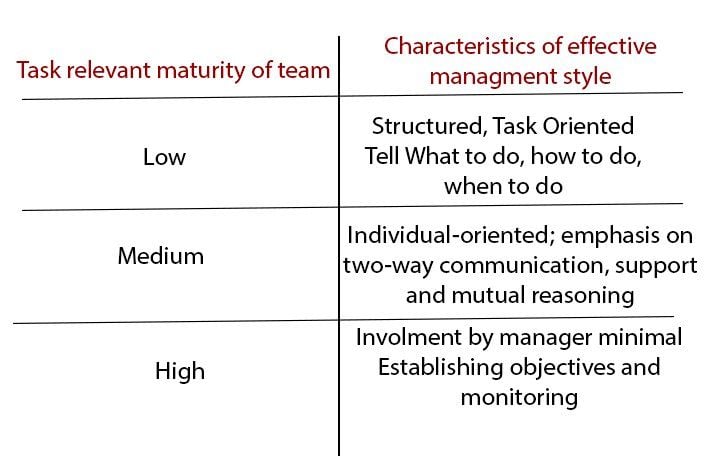We used to have no managers at Buffer. Now we have tons.
And we all have a lot of catching up to do.
For most of the leaders at Buffer, we are new to people management. We have a strong culture of nurturing people into more advanced roles and promoting from within. This is fabulous for the opportunities we can afford our teammates; however, it does lead to a steep learning curve with disciplines like strategy, vision, coaching, and mentorship that aren’t as big a part of an individual contributor role.
One of the best resources we’ve found is the Lighthouse blog, which is written by Lighthouse founder Jason Evanish (Lighthouse is a great app for better 1:1s). Jason graciously agreed to have a call with our managers to share his insights — insights which we’d love to pass along to you if they’d be helpful as you level up your management skills.
Here are the biggest questions we had for Jason and the answers and ideas he shared.

1. How can a manager best prepare for a 1:1?
One-to-ones are like a Swiss army knife. Each one will be very different every time.
The more you can think of 1:1s as a multi-tool, the more you’ll gain from them. Some people narrowly define what is in a 1:1, which makes the meeting a bit more restricted. Instead, the best way to approach things is to be flexible and open.
Some things you can prepare in advance:
- Your feedback and coaching for the teammate
- Context about what is going on in the company currently
- Open-ended questions to get to know each other better
And some things you can do to encourage your teammate to come prepared:
- Remind them, “If you want feedback on something, please ask.”
- Remind them, “If there’s something you want to talk about, the 1:1 is the best way to do it.”
One-to-ones are an ideal place to discuss career growth, too. In this case, you’ll want to give your teammate advance notice so they can prepare ahead of time.
Further reading:
—
2. How often should you do 1:1s?
The short answer: At least once per month.
Most good managers meet weekly unless their size of team pushes it to bi-weekly.
One of the key concepts to help determine the frequency of a 1:1 is a teammate’s task-relevant maturity (TRM).

From the book High Output Management, TRM describes someone’s familiarity with a task or team. If someone is new to a task or responsibility, a manager may need to be more hands-on. Meet with new hires and people with new roles or responsibilities weekly. They might be feeling lost.
It can be scary to admit you’re struggling or when you need help. As managers, it is important to be there to support them, and a 1:1 provides a safe space to discuss this, as well as general coaching and feedback.
You can always scale back if you need to. But you should always be thinking, “What do they need to know? How are they doing? What is their task-relevant maturity (not just length of time in the company)?”
Further reading:
- Task-Relevant Maturity: The Most Important Management Concept People Miss
- Why Once a Month is Often Not Enough and Why Quarterly is Way Too Infrequent
—
3. How many direct reports is too many?
No one should have more than ten.
Jeff Bezos has a two-pizza rule.
Tomas Tunguz says that seven, plus or minus three, is best (so 10 direct reports maximum).
The tricky thing with adding more direct reports is that the lines of communication get incredibly complicated, incredibly fast. This image from Stack Overflow does a good job showing just how much complexity arises as you add more people to a team:

Often, managers are rewarded for doing a good job by having bigger and bigger teams. Unfortunately, it gets harder and harder the more people are on your team as demonstrated in the image above.
So if your team is starting to grow to seven or more, you may want to start thinking about identifying potential leaders on your team and developing them. That way, when you get closer to 10 or more reports, they’re ready to take some responsibility for managing others so everyone can get the attention they deserve.
—
4. How would you approach managing someone who is a subject-matter expert when you’re more of a generalist?
In this case, it’s all about how you shape the discussion in your 1:1.
Focus on the impact of your teammate’s work rather than the specifics of the work itself. Or, to put it another way, the manager can ask the teammate to teach them about what they’re doing. Show them how good and bad results affected the end user (internally or externally) and take any interest in their thought process to tackling these challenges.
For generalists who manage subject-matter experts, it’s less about the nuts and bolts and more about the end result and whether or not the teammate can articulate it. There’s a reason rubber duck debugging — the idea that an engineer should be able to explain one’s code so that a rubber duck could understand — can even be very effective, and you’re definitely smarter than a rubber duck.

—
5. What is one of the biggest mistakes you can make as a manager?
The biggest mistake managers make is missing the importance of the fundamentals of good management. It’s easy to think there is a silver bullet, but in searching for the silver bullet, managers often risk overlooking the fundamental habits of good management.
The book, First, Break all the Rules, describes managers as always being on stage. The team is always watching. If you do things right 90 percent of the time, that’s nice, but the team is likely to catch that one thing you do wrong. This is where habits become so important. The habits will help make it easier to have the consistency you want and to avoid being the “do as I say not as I do” manager.
Don’t downplay simple things or habits that ensure good things happen.
The things that can put you in the top percentage of managers are the simple habits: Keep effective 1:1s with your team, make them actionable and accountable so you’re both making progress together on what you discuss, and ensure your team members are growing and developing.
Further reading:
—
6. What can you do when people want to move roles but it’s either hard for that to happen logistically or not best for the company at the moment?
Sometimes things don’t work to have someone take on a new role.
Sometimes you get lucky.
Unfortunately, in a lot of cases, you don’t get that luck, and you have to say no for now.
But you can still help them grow. Work with them on the skills they want to build in exchange for doing good work in their current role. If they really want to do something different, they’re going to leave eventually anyway. However, by making this agreement with them, you’ll get the best work from them until that happens.
Often, growth and development are just about a teammate feeling like they’re building new skills that they’re interested in. This often means they’ll stay in their current role as long as five to 20 percent of their time is on things they really enjoy or feel challenged by. There are lots of alternatives beyond a role change that can motivate an employee.
In a TED Talk by author Dan Pink, he shares three keys to motivating teammates intrinsically:
“Autonomy: the urge to direct our own lives.
Mastery: the desire to get better and better at something that matters.
Purpose: the yearning to do what we do in the service of something larger than ourselves.”
By focusing the teammate’s growth on a project they’re passionate about, you hit all three of those areas.
—
7. Should you give praise to all your direct reports equally? Is it okay if some people get recognition and others don’t?
If you want to get the best out of your people, you should praise the heck out of anyone delivering.
If you praise people who don’t deserve it, they’ll feel it’s shallow, and you cheapen praise for real quality work. If you hold back on praise because it would be “unfair” to praise your best people more, then you’re depriving them of positive vibes you could give them, thus discouraging them from putting in more effort.
Pay attention to the person as well. People prefer different forms of recognition, so while one person may love having the whole company told how great a job they did, it can make others cringe. The latter may prefer a more private form of gratitude.
Further reading:
—
8. Is it okay to spend more time with your best people?
Yes!
In First, Break All the Rules, they talk about investing in your best people because they have the highest return.
Plus, part of being a 10X person is not just one’s own productivity. What makes someone 10X is how they’re able to make others around them better.
One of the best examples of this, from First, Break All the Rules, is the story of Jean, a data entry employee.
Among Jean’s peers, the national average for data entry was 380,000 punches per month. Jean averaged 560,000, a full 50 percent above the national average.
Noticing this, her manager invested more time and energy in Jean, and three months later, she reached 1,000,000 punches per month. She and her manager continued to work closely together, and six months later, she reached 2,000,000 punches. Since then, she’s gone on to set a personal high of 3,526,000 punches in a month, and her company has taken Jean’s profile, strategies, and work ethic and shared them with the existing team and in the hiring process for new recruits.
The monthly average for everyone who works near Jean is now over 1 million.
—
9. How do you talk about career growth if the teammate doesn’t have a clear vision for where they want to get? What about if there are not traditional growth opportunities available at the company?
For those who don’t have the career vision …
You can take it back to the basics to find out what the teammate likes about his or her job, what gets them excited. Sometimes special projects can let them dip their toes in the water of a new role they might not have pictured for themselves. Hack days, for instance, are a great time for people to experiment.
If they are still not sure, it’s okay to focus on the people who do know what they want.
The people who are uncertain will eventually be hungrier and more demanding of that attention. Also, seeing others growing may channel their energy in a good way and show them where they could go.
Sometimes things in one’s personal life might prevent a teammate from thinking too much about career growth at the moment. In this case, it’s okay to say, “When you’re ready, I’m happy to have this conversation with you.” (And then be sure to check back in every few months.)
When traditional career ladders aren’t available …
You can focus the teammate on getting better at their existing role or broaden their focus. They can become a T-shaped employee, going deeper in what they do today and becoming a subject matter expert.
As a manager, you always think as a coach. “Where can I put people in a place where they’ll thrive and grow?” Keep this in the back of your mind and look for opportunities. This will make your teammates feel valued. and perform better; another lesson from First Break All the Rules is that the best, most engaged teams are those that allow people to work on their strengths every day.
It’s not always about making more money. It’s about learning and growing. Find out what is intrinsically important to them.
—
10: How can you get more feedback as a manager?
There are several ways to encourage feedback. Here is Jason’s advice:
1. Ask
Ask your teammates good, specific questions like:
- How could we change our team meetings to be more effective?
- Would you like more or less direction from me on your work?
- What could I do to make you enjoy your work more?
- Do you feel your ideas are heard by the team and myself?
- What part of the day do you have the most energy and focus? What changes could we make to accommodate this?
2. Be grateful and receptive to feedback
Next time you get feedback from a team member, try this approach to ensure you continue getting feedback from them:
- Pause and thank them for the feedback before you say anything else.
- Ask them to share a recent situation where the feedback applies.
- Ask clarifying questions to ensure you understand the core of their feedback.
- Talk about possible solutions or changes with them, or explain the context they need to know.
3. Turn feedback into action
- You change something: Your actions will validate their courage to give you feedback.
- They change something: You empower them to help create the kind of company that they want to work for.
- You explain why it is that way: When you can’t change something, helping them understand why it is that way can help them empathize and better tolerate things.
Further reading:
—
Bonus: How do you deal with signs of burnout in your team?
If you feel like a lot of your team is burning out, that’s a warning sign for you and how you’re managing.
If it’s one person, then that’s a signal to dig in and understand their situation in particular. (Often it’s the emotional side of their work; it’s not just workload, it’s happiness in what they’re doing)
As a manager and in your 1:1s, you can keep asking how people are feeling. See how much time off they’ve taken, and nudge them to take more if needed. For instance, if you see someone who isn’t taking advantage of vacation, nudge them to do so.
Everyone needs to recharge sometimes.
Remember that you’re always on stage as a manager: The things you reward, the things you pay attention to, the things you give feedback on, those are the things that will be noticed (that includes *you* taking a vacation to show it’s okay to do so).
—
Thanks again to Jason of Lighthouse for helping our managers on the call and sharing the tips here for the Buffer blog!
Over to you
We’d love to hear your management experience and insight.
- What are the most important lessons you’ve learned as a manager?
- How do you approach your 1:1 relationships with teammates?
Try Buffer for free
190,000+ creators, small businesses, and marketers use Buffer to grow their audiences every month.




